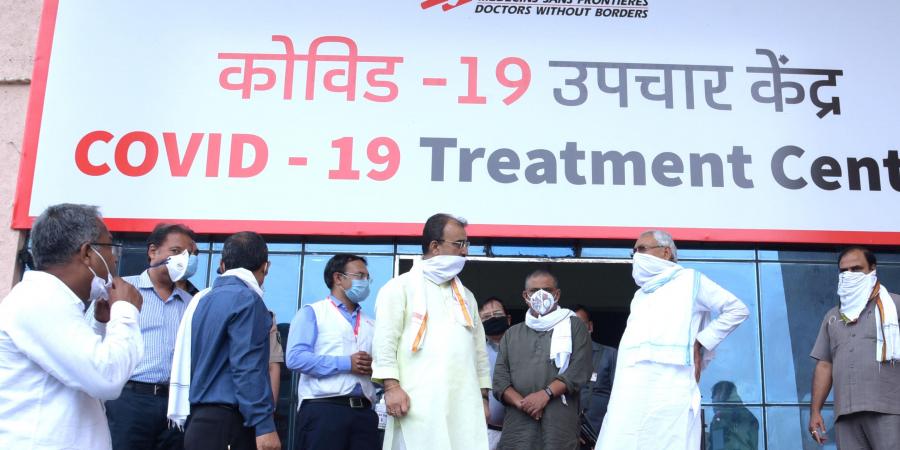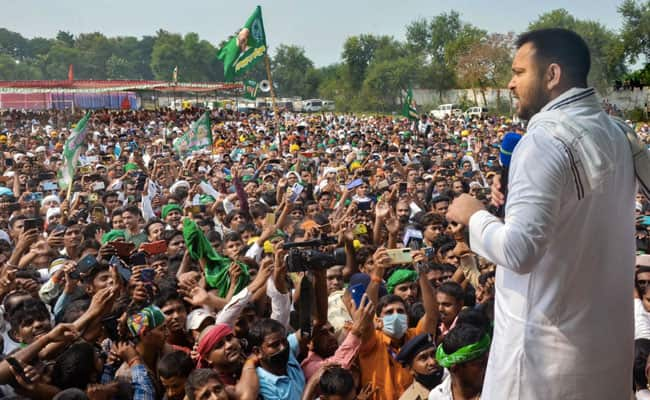The entire country is battling the coronavirus crisis and realising that years of neglecting the public healthcare system has not only been a grave mistake but also one that is steadily weakening our fight against the pandemic. But as the assembly elections set in a new wave of excitement and festivity into Bihar, we saw the state pretending as if it had defeated the coronavirus and had become free of the virus unlike any other part of the country.
In electoral rallies, in public meetings, on roads and highways, marketplaces and residential colonies, in rural and urban areas- images and videos covering people’s voices ahead of the polls, clearly showed the masses boycotting the usage of masks and pretending as if the pandemic was nothing but a rhetoric manufactured by the Opposition to amp up its own political game and ensure that the ruling party got a bad name. It is sad that while the public seems to have forgotten the gravity of the pandemic and life seems to have come back to its pre-pandemic normalcy, it is worth asking whether Bihar was really able to fight away the coronavirus pandemic and become virus free or was data related to the impact of the pandemic manipulated and hidden in the context of the upcoming Bihar polls.
Did Biharis Really Scare the Coronavirus Pandemic Away?

Thus, the rhetoric that people of Bihar have been forced to buy regarding the eradication of the virus is false and problematic and nothing but a gigantic risk that could affect thousands of people in the state. The pandemic is by no means over in Bihar, just like in any other part of the country. It is an all-pervasive reality today and neglecting it or taking it lightly will only land us into risk and bring us closer to an unprecedented health crisis. If we look at data from Bihar we would understand that on an average Bihar recorded 500 cases per day till the first week of July and this rose to nearly 3,800 cases by the second week of August. In the subsequent months, we did see the number of cases gradually fall down and from September -October, cases have been recorded at about 1,200 every day. The number of deaths related to coronavirus had also declined but in the past couple of weeks they have been rising again.
Let us not undermine the fact that the capital of Bihar, Patna has been the biggest contributor to the rising coronavirus cases in the state and is also the region to have recorded the highest death toll.
It is to be noted that the number of coronavirus positive cases found in Patna had grown sharply in August, dropped after that but since September-October, such cases have again seen a sharp increase.
Low Testing Doesn’t Mean that COVID-19 is Over in Bihar

There has been a commonsensical feeling among many people across the length and breadth of the state that unlike the other states, Bihar has become coronavirus free and that there is no reason for people to restrict their movement, follow the protocols of social distancing or to watch out for infection, there are many who would even argue that the pandemic is nothing but empty rhetoric and false propaganda. This widespread perception has steadily impacted people’s seriousness in dealing with the pandemic, the level of care and precaution that they are taking to keep themselves free from infection or to get access to medical care in case symptoms appear. One of the greatest reasons for a widespread public perception in Bihar that there is no coronavirus in the state has much to do with low testing. Beginning from the month of July, the state came into public light for having one of the lowest testing rates in the country. Low tests meant that a lesser number of people or a lower ratio of infected people compared to other states was coming out into the public domain, this made people think that the state has been far less impacted by COVID-19 than other parts of India.
In August we saw that the government increased testing and not surprisingly, it was found that the number of people who were found to be COVID-19 positive also multiplied ten fold. So in July it was 10,000 and in August it turned to 1 lakh. This was evident to show that low testing didn’t mean that a lesser number of people were being infected, it only meant that lower testing wasn’t allowing the data on the magnanimity of infections to come out in the public domain.
The second problem that is being faced by Bihar as far as the pandemic is concerned is that although testings were increased in Bihar following sustained critique in the media, most of the tests that were conducted were Rapid Antigen Tests(RAT).
If one were to look at the counts from September, more than 86% of all the tests that were conducted were RATs. Even though it was not as effective in asserting the impact of COVID-19 in Bihar, the detection levels for the COVID-19 pandemic became greater and it became evident that far from being virus free, infections were growing in Bihar. Owing to the low sensitivity of RAT tests, Bihar’s COVID-19 case count began to decline sharply and the sharp decline can be understood from the fact that it was 15% in July, 2% in August and is at present less than 1%. One has to underline that positivity levels on RAT tests were seeing a rapid decline but the COVID-19 cases were rapidly growing in the state.
Here lies the catch, we have to understand that RAT tests are good means of ensuring disease surveillance and when conducted only successfully detect a minute portion of COVID-19 positive cases and miss out a significant portion. This means that although RAT tests can at times detect the presence of COVID-19, it also is likely to leave behind or keep undetected a significant proportion of such cases and this makes it look like positive cases are rapidly falling in Bihar.
The other demographic factors that seemed to have worked in Bihar’s favour are the prevalence of a youthful population( according to the Census 2011, 37.3% of Bihar’s population is 0-14 years old) and we know that young people are better equipped metabolically to fight the COVID-19 infection and secondly, we should also underline the fact that Bihar has the second largest population out of all the states in India where the chunk of the population still lives in villages.
According to projections made for the year 2020, 88% of Bihar lives in villages.
Living in villages has a distinct advantage because the COVID-19 pandemic has largely shown the worst impact in urban areas where population density is the greatest. No wonder, the Capital city of Patna which is considered to be Bihar’s most developed and urbanised district reported the largest share of infections and deaths in the whole state.
The correlation between development, urbanisation and spread off infection seem to be clearly established in the case of Bihar.
No Spread of COVID-19 Infection or Inadequate Reporting of Deaths?
The remarkably low reportage of COVID-19 infections in Bihar is possible due to a plethora of causes, among them inadequate reporting of fatalities and positive cases as well as demographic reasons are key. It is possible that although Bihar had been impacted as gravely as other parts of the country, this was not shown in the figures brought out officially in the public domain. Given the fact that Bihar has a very low reporting of deaths and a large number of deaths occur without family members applying for a medical certification, it is possible that such has also been the case amid the pandemic.
It is then extremely important to understand that COVID-19 has neither ended nor subsided in Bihar. What remains extremely significant to ask is whether data of COVID-19 infections in Bihar was manipulated to ensure that prior to the elections, citizens believed that their state unlike any other state in the country had won the battle against the coronavirus pandemic. Low testing, preference to RATs, low recording of fatalities and insignificant representation of a large number of districts in Bihar should all be looked at with a critical lens.
If the whole world is fighting the COVID-19 pandemic, and even the developed world is being tossed and toppled by the gravity of this issue, how is it possible for Bihar to have defeated it?


